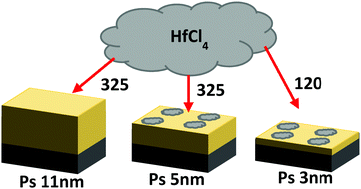Rapid area deactivation for blocking atomic layer deposition processes using polystyrene brush layers†
Abstract
Research into the fabrication of polymer brushes for use in Area Selective Deposition (ASD) is vital for the understanding of ‘bottom up’ lithographic techniques such as block copolymer (BCP) lithography. Polystyrene has been extensively studied as a blocking material and has been shown to reject both liquid and vapour phase precursors in block copolymer structures. In this work, we demonstrate that thin polystyrene brushes can effectively block atomic layer deposition processes (ALD), offering a route to area deactivation. The effect of varying the molecular weight and fabricating solution concentration of polystyrene (PS) on the overall brush thickness using the grafting-to method is presented in detail. Ellipsometry shows that an increase in molecular weight and solution concentration yields an increase in brush thickness. We demonstarte that PS brush thickness has a significant impact on the blocking efficacy of a HfO2 ALD process, using X-ray photoelectron spectroscopy as the primary characterisation technique. Results show that the thickest brushes fabricated in this work successfully blocked a process that would result in 19 nm of HfO2 on native oxide covered Si. Due to the significantly faster fabrication times of PS brushes, this process is deemed a highly competitive alternative to the more widely used ASD methodologies such as self-assembled monolayers (SAMs).



 Please wait while we load your content...
Please wait while we load your content...